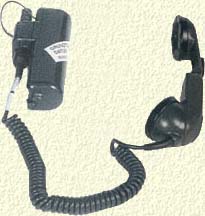| Range: | 3 km | |
| Weight: | 1 kg | |
| Frequencies: | 6 pre-programmed channels | |
| Battery life: | 15 h |
 The RA180 is a larger radio that you attach
to the frame on your backpack. It has two different types
of antenna with varying ranges, and the antennas and
other gear are stored in a bag on one side. It is a
digital radio with pre- programmed channels. It has a
secure mode, in which the radio jumps between various
channels very quick (several times per second), which
means that the radio is very hard to detect or jam. It
also has a special network setting so one radio can relay
signals from other nearby radios, forming a network. Such
a network can be very large and widespread, permitting a
range much larger than for a single radio in standard
mode.
The RA180 is a larger radio that you attach
to the frame on your backpack. It has two different types
of antenna with varying ranges, and the antennas and
other gear are stored in a bag on one side. It is a
digital radio with pre- programmed channels. It has a
secure mode, in which the radio jumps between various
channels very quick (several times per second), which
means that the radio is very hard to detect or jam. It
also has a special network setting so one radio can relay
signals from other nearby radios, forming a network. Such
a network can be very large and widespread, permitting a
range much larger than for a single radio in standard
mode.| Range: | 4-12 km | |
| Weight: | 12 kg | |
| Frequency: | 30-76 MHz (2320 channels) | |
| Battery life: | 10 h |
 The RA195 is a large radio, somewhat similar
to the RA180. It is equipped with a standard antenna,
which isn't used very often. Instead, you normally use a
dipolar antenna (basically a long wire) that you attach
between two trees. The dipolar antenna has a much longer
range, but weighs more and takes more time to set up. For
this reason you normally set up the dipolar antenna in
your main base for the duration of a mission, and use the
standard antenna when on patrol or ambush. When equipped
with a dipolar antenna, the range of the radio is almost
unlimited, since the low frequency waves bounce off the
atmosphere. With the right weather conditions, you can
send up to several hundred kilometers.
The RA195 is a large radio, somewhat similar
to the RA180. It is equipped with a standard antenna,
which isn't used very often. Instead, you normally use a
dipolar antenna (basically a long wire) that you attach
between two trees. The dipolar antenna has a much longer
range, but weighs more and takes more time to set up. For
this reason you normally set up the dipolar antenna in
your main base for the duration of a mission, and use the
standard antenna when on patrol or ambush. When equipped
with a dipolar antenna, the range of the radio is almost
unlimited, since the low frequency waves bounce off the
atmosphere. With the right weather conditions, you can
send up to several hundred kilometers.| Range: | 10 km (standard antenna) 500 km (dipolar antenna) |
|
| Weight: | 20 kg (including dipolar antenna) | |
| Frequency: | 2-30 MHz | |
| Battery life: | 4 h |
 This is wire-based system, consisting of two
phones connected with a double signals wire. This may
sound primitive, but it is very usefull in your main
base. In your main base you generally have a sentry
located about 200 meters away, who watches over the
incoming trail. From the base to the sentry you drag out
the wire, placing it in the snow, and connect the two
phones at each end. This is a great way of maintaining
contact with the sentry, since it is a two-way system
(like an ordinary civilian phone). Each phone has it's
own powersupply (the little cylinder shaped box) from 2
AA batteries. The system is very battery efficient and
does not emit any radio signals, which is a great
advantage compared to radio equipment, since it can not
be detected by the enemy.
This is wire-based system, consisting of two
phones connected with a double signals wire. This may
sound primitive, but it is very usefull in your main
base. In your main base you generally have a sentry
located about 200 meters away, who watches over the
incoming trail. From the base to the sentry you drag out
the wire, placing it in the snow, and connect the two
phones at each end. This is a great way of maintaining
contact with the sentry, since it is a two-way system
(like an ordinary civilian phone). Each phone has it's
own powersupply (the little cylinder shaped box) from 2
AA batteries. The system is very battery efficient and
does not emit any radio signals, which is a great
advantage compared to radio equipment, since it can not
be detected by the enemy.encryption:
| There are two systems for sending and recieving text messages, the DART 380 (top) and the KV-DART 301 (bottom). The DART 380 is used with the RA180, and the KV-DART 301 is used with the RA195. The systems are similar, both having a keypad and a display window, weighing around 2 kg each. With these you can type and store text messages, send and recieve messages, as well as encrypt and decipher text. You can also use them for various mathematical calculations. When sending a text message that you have made you can use a special burst function, so the text is sent in less than one second, making it very difficult for the enemy to locate the transmitter. |   |
generator:
rangefinder: